This website is supported by its readers. If you click one of my links I may earn a commission. I am also a participant in the Amazon affiliates program and I will also earn a commission from qualified purchases.
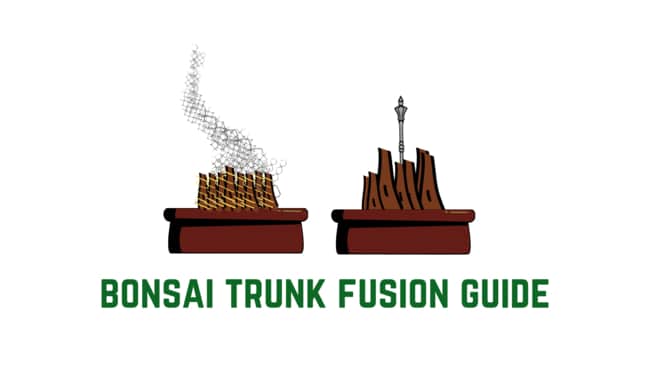
Now that I’ve got about a year of solid bonsai keeping under my belt I want to branch out (all puns intended) and start growing my bonsai from cuttings. One technique I came across to help create a dense bonsai trunk is by using bonsai trunk fusion. So what exactly is it?
Bonsai trunk fusion is a grafting technique used to fuse multiple smaller bonsai trunks from rooted cuttings or fresh seedlings into one larger trunk. These are secured together against a metal mesh, attached with paper ties or wire, and left to fuse over a few years.
This is typically done by tying these root cuttings together with a string or by using plastic wire on the outside to fuse.
Bonsai trunk fusion will take a few years to complete so will require a few years of patience.
So how exactly can you start bonsai trunk fusion? And what are the advantages and disadvantages of bonsai trunk fusion? Keep reading to find out more!
Just a quick heads up, over the past three years of running Plantpaladin, hundreds of people have asked for product recommendations. As such, You can find my favorite indoor bonsai tree here (link takes you to Bonsaiboy), my favorite outdoor bonsai tree (link takes you to Bonsaiboy), or have a look at all the products I recommend here.
What is bonsai trunk fusion?
Bonsai grafting techniques are incredible.
When I first learned about these it blew my mind.
The general idea is that you can attach cuttings or branches from one bonsai to another and after a few years of care and maintenance, they will fuse.
Bonsai trunk fusion is no different and is a technique that has been popularised in recent years.
So what is bonsai trunk fusion
To summarize:
- Bonsai trunk fusion is a grafting technique used in bonsai.
- It is used to merge multiple rooted cutting trunks.
- This will create a stronger bonsai trunk that is easier to grow and taper exactly the way you want.
- The general premise then is that you would take a few cuttings from an existing plant – usually at a minimum of 6 or 7 – taken from the branches.
- You can also plant 6 to 7 fresh seedlings for this technique.
- You would plant these in a pot to develop a root structure and grow the trunk of these out for about a year or so.
- These cuttings or seedlings will be planted in a circle to help them fuse later.
- Then, once these cuttings/seedlings are strong enough you would either place a metal mesh or metal pole in the center of the cuttings and tie them together either with wire or paper ties.
- This will typically be done in early spring before the seedlings or cuttings break the dormancy.
- Finally, leave the seedlings/cuttings attached to the wireframe mesh until fused – ensuring you do nothing but water and fertilize your plant.
- Typically the process of fusing bonsai trunks will take around 1-2 years to be completed depending on the number of seedlings or cuttings that need to be fused.
How to fuse bonsai trunks
So now we know what bonsai trunk fusion is, how exactly do you fuse bonsai.
The main steps involved are as follows:
- Select your bonsai species
- Visualize how you want your tree to look
- Grow out your seedlings or cuttings
- Place a metal mesh or pole in a drainage pot
- Replant your seedlings or cuttings around the mesh
- Attach your seedlings or cuttings with paper ties or wire
- Water and fertilize your new bonsai regularly
- Wait for 1 to 2 years
It’s also worth noting that you will need the following:
- Bonsai cuttings or seeds
- Bonsai drainage pot with holes (link takes you to Amazon)
- Paper ties, plastic wire, PVC tape, or string (link takes you to Amazon)
- A metal mesh or pole (link takes you to Amazon)
- Fertilizer of your choice
Let’s explore these in more detail:
Select your bonsai species
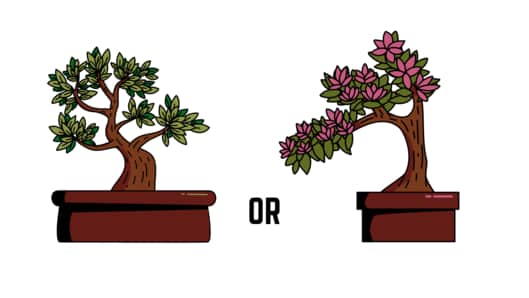
So before we do anything else, we need to decide on the type of bonsai we want to fuse.
Now as cool as it would be to graft and fuse together a Juniper to a Chinese elm, the truth is that most bonsai species or plant species at that, cannot be grafted against each other.
As such ensure that the bonsai you will fuse, will be from the same species.
I’ll cover in more detail later on the best species used for trunk fusion.
Visualize how you want your tree to look
This step is one of those things where if you don’t follow, you can mess up your tree.
You see the wire mesh or metal pole that will be used to attach our cuttings or seedlings to, will need to be molded into shape.
Especially if we want our bonsai trunk to look a certain way or if we want to create a bend in the trunk of our bonsai.
One of the best things I found for this then is to simply draw out how we want our bonsai tree to look.
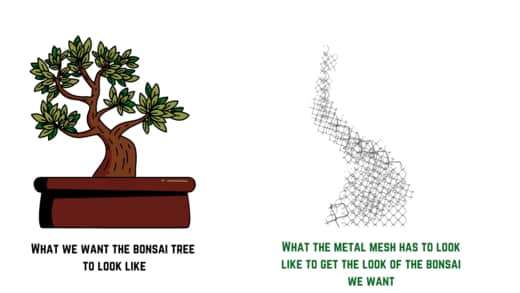
You can then trace over this or come up with a design for how your metal mesh will look – giving you a clear image of what your mesh or pole needs to look like in the later steps.
Grow out your seedlings or cuttings
So now we know what bonsai we will be fusing and how we want our bonsai to look, we need to create some seedlings or cuttings to fuse.
The technique used will depend on whether you use seedlings or cuttings.
For both methods, however, I would strongly advise you to plant these in individual small pots – so one pot per seedling or cutting.
Growing them together in the same pot will make it a lot more difficult when we need to repot the bonsai with a metal mesh or pole.
Let’s explore these both:
How to use seedlings for bonsai trunk fusion
So using seedlings is the method I prefer, after all, why go through all the hard work of growing out a bonsai and then cutting off valuable branches that took so long to grow.
To use this method then simply, find the bonsai seed for the species of bonsai you would like to grow.
Then plant in a soil pot and grow out for about a year or so – the ideal time to plant would be just before the spring months and the growing season starts.
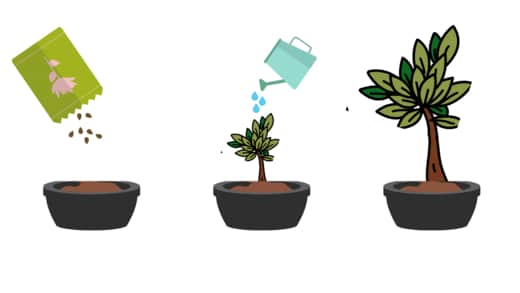
You mustn’t prune the seedling at this stage at all, instead, focusing only on watering and fertilizing – all we want to do is develop a small root structure.
When your seedling is a few inches in height (again usually after a year), it is ready to be used for fusing.
How to use bonsai cuttings for bonsai trunk fusion
The second method then would be to use bonsai cuttings for trunk fusion.
To use this method; use a sharp pair of bonsai branch cutters and trim a few branches from a healthy bonsai.
Ideally, the bonsai you will be trimming the branches from will be around 20 to 30 years old or a medium-sized two-handed bonsai – these tend to work best.
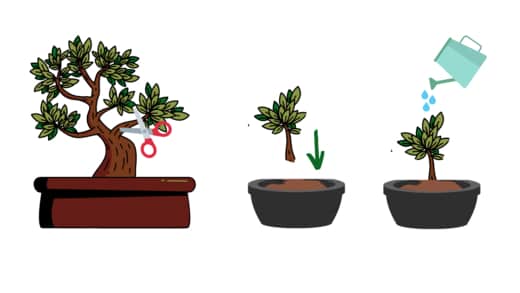
It’s also important that you only do with is with secondary or tertiary branches as primary branches may be too strong already.
Then once removed, similarly to the seedling technique, plant in a pot with drainage holes, water and fertilize regularly for about a year or until the branch develops a root system of its own.
Place a metal mesh or pole in a drainage pot
Once your seedlings or cuttings have been primed and grown enough to be fused we need to start looking towards a metal mesh.
This mesh will go in the center of our plant pot and give support to our seedlings and cuttings in the early days of them getting fused.
Now if you are interested in just a straightforward bonsai with one thick long trunk then I would suggest planting a metal pole or rod in the center.
If however, you would like your trunk designs to be more artistic then a mesh would be the best option for you.
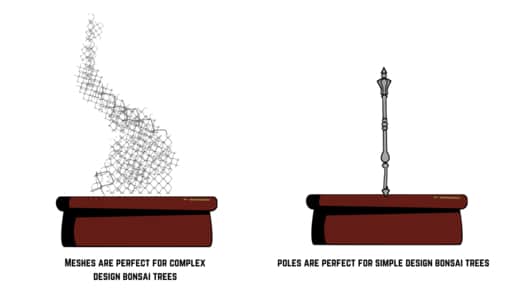
To plant, simply fill a new drainage pot with a bonsai soil mix, I like to use a volcanic ash mix or cactus soil.
Then place the mesh/pole in the center of the pot ensuring it is a few inches deep in the soil.
What is the best wire mesh material?
If you opt for the wire mesh technique for a stylish bonsai trunk then I would suggest you go for hardware cloth, (link takes you to Amazon) which is easy to manipulate and shape with a pair of pliers.
Now, this can sometimes be hard to come by so if you can’t find this, chicken wire works well.
Once your bonsai has been fused, the metal mesh will also fuse and become part of your tree.
What is the best metal pole material?
If you want to keep things simple and opt for a metal pole then a standard metal pole used for cucumbers or strawberries works best.
My suggestion would be the Ativa metal pole, which you can get here from Amazon.
What’s good about this is that as they are 5ft long you can cut them into specific sizes for your bonsai and will have plants left over should you do this again in the future.
Replant your seedlings or cuttings around the mesh
Once your mesh or metal pole is in place you need to replant your cuttings or seedlings around them.
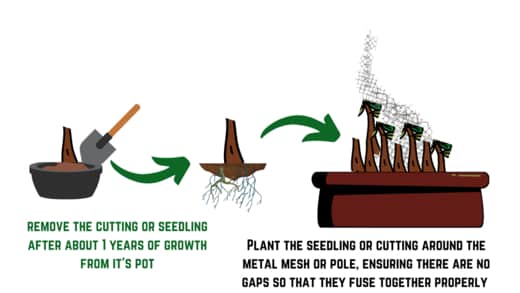
To do this, simply remove from the pots that they are growing in and plant in a circle around the metal mesh.
The good thing about replanting them at this stage is because your seedlings or cuttings have only been growing for around a year or so, in their pots, their root systems should not be too difficult to manage.
The most important thing though is to make sure there are no gaps when you fasten them to the metal pole or wire.
If you find that your bonsai cuttings or seedlings do have too many roots, then check out my post on repotting bonsai here which should help explain the process.
Again, the idea here is to repot the seedlings or cuttings around the metal mesh or wire we have laid out in the last step.
Attach your seedlings or cuttings with paper ties or wire
Now your metal mesh and cuttings/seedlings are in the same pot, we need to attach them together.
While it might be tempting to use traditional copper wire as we would for other bonsai techniques, it’s important to use something less rigid.
This is because during the fusing process these copper wires can damage your plant, cutting off the circulation of the tree and even become a part of the fusion process.
The best option would be to use paper ties.
Tie each individual bonsai together and to the metal mesh in each of the holes using the paper ties.
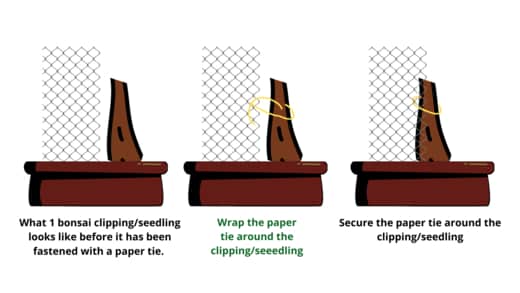
You really want to use as many paper ties as possible.
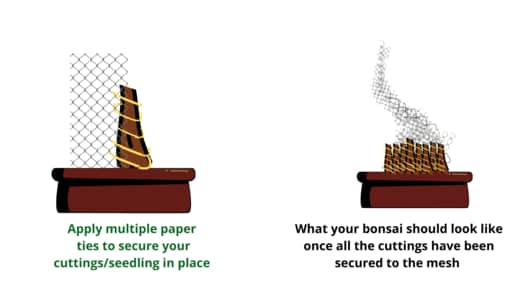
As the bonsai grows these will naturally fall off and not cause any damage to your tree.
Once your cuttings/seedlings are attached to your metal mesh, I would then use plastic wiring or string and wrap the bonsai trunks together to create another layer of stability.
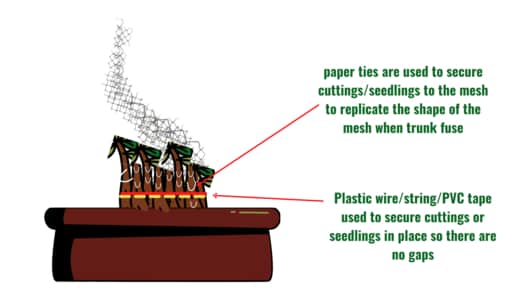
What about the metal pole
Now if you used a metal pole instead of a metal mesh – attaching paper ties will be very difficult.
The best option then would be to either use plastic wiring, string, or PVC tape.
Each of these won’t damage your tree anywhere near as much as traditional copper wire.
To use, simply wrap the wire, string, or PVC tape around each of the cuttings/seedlings from the base of the topsoil to about halfway up the metal pole.
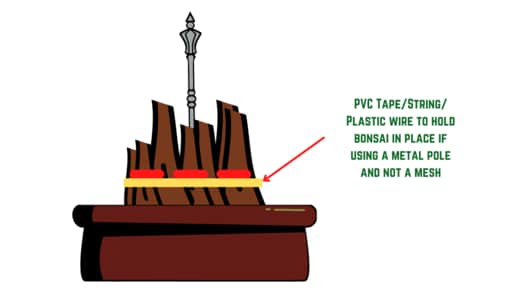
Water and fertilize regularly
The next stage is often the hardest part – patience.
It can be tempting to want to prune or trim your bonsai but for the next year or two, the most important thing you do is to water your bonsai regularly – ensuring you don’t overwater or underwater your bonsai and fertilize your bonsai regularly.
Avoid pruning at all costs or interfering with your tree unless you think your bonsai is getting a fungal infection or insect infestation.
During the spring and summer growing season I would also keep your bonsai outdoors for as long as possible to maximize its ability to use photosynthesis to help the fusing process.
Wait for one to two years
Finally, after about a year or two of care, watering, and fertilizing your bonsai seedlings or cuttings should be fused together to create a strong trunk.
The paper ties should have eroded by this point.
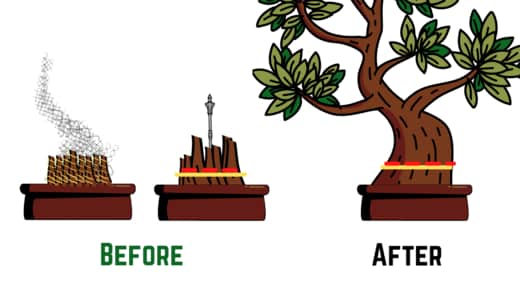
The last thing you will have to do is to remove the plastic, wire/string/PVC tape that was holding the outside of your bonsai together.
You now have a bonsai that has been fully fused!
You can then care for this bonsai like you would for any other in your collection.
Advantages of fusing bonsai trunk
So now we know the exact process to follow to fuse bonsai trunks, what are the major advantages of fusing bonsai trunks?
Avoiding damaging the trunk
The biggest advantage is that we don’t damage the trunk of the bonsai with bonsai trunk fusion.
Traditional techniques for thickening a bonsai trunk are often done by cutting the bonsai trunk and letting it grow back stronger.
Whilst this method is fast it can damage the trunk of your bonsai leaving scars.
The fusion process is a natural one that won’t be as intrusive.
It is fast
Bonsai tree maintenance is a patient game, with a lot of bonsai owners waiting decades to get their bonsai tree to look the way they want.
Bonsai trunk fusion then, by all accounts is a relatively fast development with it typically taking between 1 and 5 years usually to complete.
Added nebari
Nebari is often sought after in bonsai – it’s the appearance of gnarly branches and roots at the bottom of the tree.
A lot of bonsai owners spend years trying to get this on their trees to get visual balance.
By using bonsai fusion, having great nebari is a given as the seedlings and cuttings join naturally.
Set and forget it
Aside from the regular maintenance, you would do on normal bonsai trees such as pruning, defoliating, or general upkeep, bonsai fusion upkeep is a lot easier.
Aside from regular watering or pruning, fusion works best when left to its own devices – and so is very much a set it and forget it type activity.
Tree design
As we will be using a metal mesh in most instances when using bonsai trunk fusion, you really can unleash your inner artist and design your bonsai exactly as you want from scratch.
Disadvantages of bonsai trunk fusion
Like all things in bonsai, whilst there are clear advantages, there are also several disadvantages you need to be aware of.
These include
Increased chance of disease
As the cuttings and seedlings used in bonsai trunk fusion are still relatively young they are more likely to get white spots on their leaves, fungal infections, or insect infestations.
When bonsai trunk fusion is complete your bonsai trunk will be strong however during the actual fusion process your plants may be more susceptible to disease as they focus their energy on bonsai trunk fusion.
As such you need to be vigilant to nip any of these issues in the bud.
Dead Seedlings
The more seedlings and bonsai cuttings you use for bonsai trunk fusion, the greater chance you will have that some of these cuttings or seedlings won’t sprout.
It’s one of the reasons why I suggest planting and growing them individually before bringing them together.
Should one of your cuttings or seedlings die during the fusion process, it will just take longer for the fusion process to complete – leaving gaps in the trunk of your bonsai.
As such, always keep a few seedlings handy on the side to fill the gaps if need be.
Resources
Before the seedlings or cuttings become fused, they will be fighting for resources such as sunlight and water.
Meaning that your seedlings or cuttings can grow at different rates and if unchecked can potentially kill some of the seedlings or cuttings around them by starving them of resources.
This is especially apparent in the new root system of your fused bonsai trunk so it is important to have soil that gives the proper level of nutrients, moisture, and air.
It’s also worth turning your bonsai every few days to ensure an even distribution of light.
Variation
As mentioned earlier, grafting only works when used for the same species of bonsai.
That being said, even the same species of bonsai have some genetic variation, even if you get them from the same seed packet.
A good way to overcome this would be to use root cuttings from the same tree if possible which act like clones of the parent tree.
Which bonsai species works best for fusing bonsai trunks?
Junipers, Maples, Ficus, and Chinese or Japanese elm trees work best for fusing bonsai trunks. This is because they are incredibly forgiving plants that can take a lot of damage without dying. Bonsai trunk fusion can work on any tree so long as they are fused with trees of the same species.
To help explain more I’ve put together a table below with a few best-selling bonsai trees and listed if they are easy to fuse or not.
| Species | Difficulty in fusing |
| Chinese elm | Easy |
| Japan elm | Easy |
| Juniper | Easy |
| Ficus | Easy |
| Maple | Easy |
| Cotoneaster | Medium |
| Azalea | Medium |
| Fig | Medium |
| Money Trees | hard |
| Pine | Hard |
When should you avoid bonsai trunk fusion?
Bonsai trunk fusion should be avoided in cuttings or seedlings that are diseased, have an insect infestation, or are suffering from mold or root rot. When fused these illnesses can pass from trunk to trunk, ensuring you have a weak tree trunk when the process is complete.
How long does bonsai trunk fusion take?
Bonsai trunk fusion typically takes about one to two years to achieve if your bonsai cuttings or seedlings have been secured properly in place. The more cuttings or seedlings used however the longer it can take, with some bonsai trunks taking 5 years to fuse in some instances.
Constant watering, fertilization, and care will be required to achieve bonsai trunk fusion during this time.
Is bonsai trunk fusion beginner-friendly?
Bonsai trunk fusion is not a beginner-friendly bonsai technique. As such beginners should wait until then to have at least 18 months of experience in caring for bonsai, mastering the basics before they attempt bonsai trunk fusion.
Can you fuse bonsai trunks from cuttings?
Bonsai trunks can be fused both from bonsai cuttings and fresh bonsai seedings. Ensure that both seedlings and cutting have been grown for about a year to ensure they have a small root structure. They can then be primed for bonsai trunk fusion.
How many root cuttings are needed for bonsai trunk fusion?
A minimum of 6 to 7 root cuttings or seedlings are needed to have a successful bonsai trunk fusion. The average number of bonsai root cuttings or seedlings for trunk fusion is 25 with some ranges varying from 20 to 70 depending on the size of a pot.
Should you use seedlings or cuttings for bonsai trunk fusion?
Cuttings work best for bonsai trunk fusion. This is because they will not have the genetic variation that seedlings have that may cause issues in the grafting process. Bonsai seedlings however are also a fantastic option that has been used for decades for bonsai trunk fusion.
What do the experts say?
Now I didn’t just want to give my opinion on bonsai trunk fusion so I visited my local botanical gardens and asked them about bonsai trunk fusion and bonsai grafting overall – this is what they said:
“Bonsai trunk fusion works best when utilized with bonsai cuttings from the same tree. Just ensure you let them grow a little before fusing them together”
John Naka also highlighted in his 1982 book how he managed to fuse a honeysuckle plant using nothing but vines.
Finally, I asked 10 plant paladin readers on bonsai trunk fusion asking them how many years they left their bonsai tree cuttings to fuse for, and here were the results.
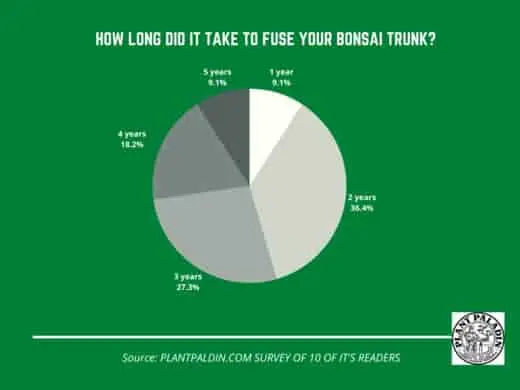
My top picks for the gear you will need!
So like I mentioned earlier, over the past three years of running PlantPaladin, hundreds of people have asked me for my recommendations on the best bonsai gear on the market.
Having spent thousands of dollars on bonsai items these past few years and tested at least 100 bonsai-specific products, I’ve listed my favorite products below – All of which I highly recommend and think you can get great value.
They can purchase directly by clicking the link to take them to Amazon.
Bonsai Tool Set: One of the significant challenges I’ve had is finding a toolset that was not only durable but didn’t break the bank. SOLIGT has recently developed a fantastic bonsai tool set that covers all the tools you need to trim, prune, and repot your trees. – You can grab it here.
Complete Bonsai Set: Many of you will want to grow your bonsai trees entirely from scratch, but finding the varicose seeds, pots, and other items in one place can be challenging. Leaves and Sole then have created a complete bonsai set that I’ve personally used that ticks all the boxes. You can grab it here.
Bonsai wire: The number of times I’ve run out of wire for my bonsai or purchased cheap bonsai wire that doesn’t do the job is embarrassing for me to admit. After a lot of trial and error, I found that using Hotop’s aluminum bonsai wire is one of the best options on the market. This can easily be used for both indoor and outdoor bonsai. You can grab it here.
This post was written by Fehed Nicass who has been passionate about bonsai for over 2 years.
